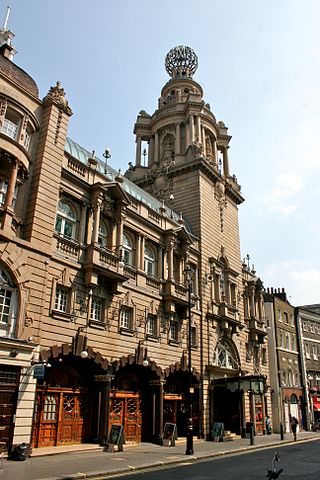
Leicester Square is a pedestrianised square in the West End of London, England. It was laid out in 1670 as Leicester Fields, which was named after the recently built Leicester House, itself named after Robert Sidney, 2nd Earl of Leicester. The square was originally a gentrified residential area, with tenants including Frederick, Prince of Wales and the artists William Hogarth and Joshua Reynolds. It became more down-market in the late 18th century as Leicester House was demolished and retail developments took place, becoming a centre for entertainment. Major theatres were built in the 19th century, which were converted to cinemas towards the middle of the next. Leicester Square is the location of nationally significant cinemas such as the Odeon Luxe Leicester Square and Empire, Leicester Square, which are often used for film premieres. The nearby Prince Charles Cinema is known for its screenings of cult films and marathon film runs. The square remains a tourist attraction which hosts events, including for the Chinese New Year.

The Empire, Leicester Square is a cinema currently operated by Cineworld on the north side of Leicester Square, London, United Kingdom.

The Odeon Luxe Leicester Square is a prominent cinema building in the West End of London. Built in the Art Deco style and completed in 1937, the building has been continually altered in response to developments in cinema technology, and was the first Dolby Cinema in the United Kingdom.

The Cinerama Dome is a movie theater located at 6360 Sunset Boulevard in Hollywood, California. Designed to exhibit widescreen Cinerama films, it opened November 7, 1963. The original developer was William R. Forman, founder of Pacific Theatres. The Cinerama Dome continued as a leading first-run theater, most recently as part of the ArcLight Hollywood complex, until it closed temporarily in March 2020 due to the COVID-19 pandemic in California. The ArcLight chain closed permanently in April 2021, with the theater never having reopened. In June 2022, it was announced that there were plans to reopen it and the former ArcLight Hollywood under a new name, Cinerama Hollywood.

The London Coliseum is a theatre in St Martin's Lane, Westminster, built as one of London's largest and most luxurious "family" variety theatres. Opened on 24 December 1904 as the London Coliseum Theatre of Varieties, it was designed by the architect Frank Matcham for the impresario Oswald Stoll. Their ambition was to build the largest and finest music hall, described as the "people's palace of entertainment" of its age.

The BFI IMAX is an IMAX cinema in the South Bank district of London, just north of Waterloo station. It is owned and operated by the British Film Institute. From 2012 until 2022, it had been operated by Odeon Cinemas.

The Prince Edward Theatre is a West End theatre situated on Old Compton Street, just north of Leicester Square, in the City of Westminster, London.
Odeon, stylised as ODEON, is a cinema brand name operating in the United Kingdom, Ireland and Norway, which along with UCI Cinemas and Nordic Cinema Group is part of the Odeon Cinemas Group subsidiary of AMC Theatres. It uses the famous name of the Odeon cinema circuit first introduced in Great Britain in 1930. As of 2016, Odeon is the largest cinema chain in the United Kingdom by market share.

The Seattle Cinerama Theatre is a landmark movie theater in the Belltown neighborhood of Seattle, Washington, United States. The theater opened in 1963 and was renovated in the 1990s after its acquisition by Paul Allen. The Cinerama was closed in May 2020. At the time of its 2020 closure, it was one of only three movie theaters in the world capable of showing three-panel Cinerama films. In 2023, the theater was purchased by the Seattle International Film Festival (SIFF) and reopened on December 14, 2023 as SIFF Cinema Downtown due to trademark issues with the "Cinerama" name.

The Headrow is an avenue in Leeds city centre, West Yorkshire, England.

The BFI London Film Festival is an annual film festival held in London, England in collaboration with the British Film Institute. The festival runs for two weeks in October every year. In 2016, the BFI estimated that around 240 feature films and 150 short films from more than 70 countries are screened at the festival each year.

The Uptown Theater, known as The Uptown, was a single-screen movie theater in the Cleveland Park neighborhood of Washington, D.C. Opened in 1936, it hosted the world premieres of such movies as 2001: A Space Odyssey and Jurassic Park. It closed in March 2020.

Odeon Leeds-Bradford is a multiplex cinema at Gallagher Leisure Park, Thornbury, West Yorkshire, between the cities of Leeds and Bradford in England.

The Odeon Marble Arch was a cinema in London located opposite Marble Arch, at the top of Park Lane, with its main entrance on Edgware Road. It operated in various forms from 1928 to 2016, and is most famous for once housing a vast screen capable of screening films in 70mm. The machines were Cinemeccanica Victoria 8 models.
The Odeon Haymarket was a cinema on Haymarket, London. Three cinemas occupied the site between 1925 and 1996, predecessors being Capitol Cinema (1925–1936) and Gaumont Haymarket (1937–1959). It became the Odeon Haymarket in 1962, before closing in 1996.

Vue West End is a nine-screen cinema complex in Leicester Square, London, operated by Vue Cinemas. The multiplex was constructed in 1993 on the site of what was previously the Warner West End cinema.
Consolidated Theatres is a Hawaiʻi-based movie theater chain. It operates six locations in the state as of August 2023, and is one of two major cinema chains in Hawaiʻi, with the other being Regal Cinemas. It screens first-run feature films, as well as some arthouse and independent films along with films from Asia.

The 66th BFI London Film Festival was a film festival that took place from 5–16 October 2022. British-American producer Tanya Seghatchian served as jury president. Marie Kreutzer's Corsage won the Best Film Award.

The 67th BFI London Film Festival is a film festival took place from 4–15 October 2023. The competition films were announced on 29 August 2023 while the films for the galas and the strands were revealed on 31 August 2023. The juries for the various sections of the festival were announced on 19 September 2023.


















